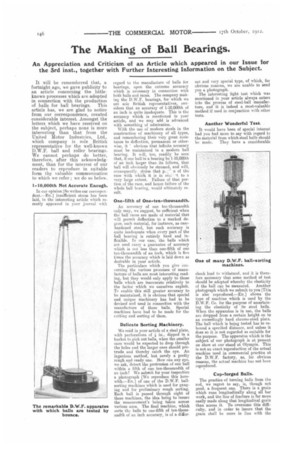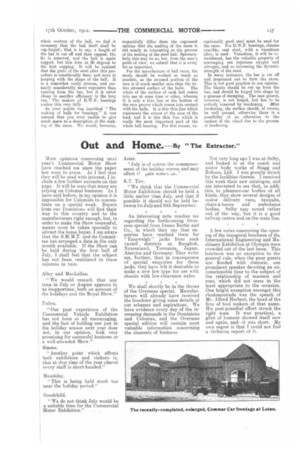The Making of Ball Bearings.
Page 20

Page 21

If you've noticed an error in this article please click here to report it so we can fix it.
An Appreciation and Criticism of an Article which appeared in our Issue for the 3rd inst., together with Further Interesting Information on the Subject.
It will be remembered that, a fortnight ago, we gave publicity to an article concerning the littleknown processes which are adopted in connection with the production of balls for ball bearings. This article has, we are glad to notice from our correspondence, created considerable interest. Amongst the letters which we have received on the subject, perhaps none is more interesting than that from the United Motor Industries, Ltd., which company is sole British representative for the well-known D.W.F. ball and roller bearings. We cannot perhaps do better, therefore, after this acknowledgmerit, than for the interest of our readers to reproduce in suitable form title valuable communication to which we refer ; we do so below.
1.40,000th Not Accurate Enough.
In our opinion [So writes our correspondent.—En.] insufficient stress has been laid, in the interesting article which recently appeared in your journal with regard to the manufacture of balls for bearings, upon the extreme accuracy which is necessary in connection with both balls and races. The company making the D.W.F. hearings, for which we are sole British representatives considers that an accuracy of 1-10,000th of an inch is quite inadequate. This is the accuracy which is mentioned in your article, and we may add is advanced with something of admiration. With the use of modern steels in the construction of machinery of all types, and remembering their very great resistance to deflection, permanent or other wise, it, obvious that infinite accuracy must be maintained in a modern ball bearing. It will, too, readily be seen that, if one ball in a bearing be 1-10,000th of an inch larger than, its fellows, that ball will obviously he stressed, and will,
consequently s,trfSS that pt n of the race with which, it is in cci,, -I to a very large extent. Failure of that portion of the race, and hence failure of the whole ball bearing, would ultimately result.
One-fifth of One-ten-thousandth.
Au accuracy of one ten-thousandth only may, we suggest, be sufficient wheu the ball races are made of material that will permit deflection to a marked degree. such material, for instance, as casehardened steel, but such accuracy is quite inadequate when every part of the ball bearing is entirely hard and inflexible. In our case, the balls which are used carry a guarantee of accuracy which is not less than one-fifth of one ten-thousandth of an inch, which is five times the accuracy which is laid down as desirable in your article.
The particulars which you give 'concerning the various processes of manufacture of balls are most interesting reading, but they would only apply to those balls which are inaccurate relatively to the factor which we ourselves exploit. Ti' enable this still greater accuracy to be maintained, it is obvious that special and unique machinery has had to be devised and used in connection with the manufacture of these balls. Special machines have had to be made for the cutting and sorting of them.
Delicate Sorting Machinery.
We rad in your article of a steel plate, with perforations of in., clipped in a bucket to pick out balls, when the smaller ones would be expected to drop through the holes and the larger ones should protrude and thereby catch the eye. An ingenious method, but surely a pretty rough agcl ready one. How can any eye, we ask, detect the protrusion of one ball within a fifth of one ten-thousandth of an inch? We submit for your inspection a photograph [We reproduce this herewith.—En.] of one of the D.W.F. ballsorting machines which is used for gauging and for preliminary rough sorting. Each ball is passed through eight of these machines, the idea being to insure the measurement's being taken across various axes. The final machine, which sorts the balls to one-fifth of ten-thousandth of an inch accuracy, is of a differ eat and very special type, of which, for obvious reasons, we are unable to send you a photograph. The interesting light test which was mentioned in your article always enters into the process of steel-ball manufacture, and it is indeed a most-valuable method if used in conjunction with other tests.
Another Wonderful Test.
It would have been of special interest had you had more to say with regard to the material from which steel balls should
be made. They have a considerable
shock load to withstand, and it is therefore necessary that some method of test should be adopted whereby the elasticity of the ball can be measured. Another photograph which we submit to you [This is also reproduced.—En.] shows the type of machine which is used by the D.W.F. Co. for the purpose of ascertaining the elasticity of its steel balls. When the apparatus is in use, the balls are dropped from a certain height on to an exceedingly hard chrome-steel plate. The ball which is being tested has to rebound a specified distance, and unless it does so it is not regarded as suitable for the purpose. The apparatus which is the subject of our photograph is at present on show at our stand at Olympia. This is not an exact reproduction of the actual machine used in commercial practice at the D.W.F. factory, as, for obvious reasons, the actual machine has not been reproduced.
Cup-forged Balls.
The practice of turning balls from the rod, we regret to say, is, though not good, a frequent one. There is a grain which runs longitudinally along all bar work, and the line of fracture is far more easily made along that longitudinal grain than across it. To overcome this difficulty, and in order to insure that the grain shall be more in line with the whole contour of the ball, we find it necessary that, the ball itself shall be cup-forged ; that is to say, a length of the bar is cut off and then cupped, the fin is removed, and the ball is again cupped, but this time at 90 degrees to the first cupping. It will be realized that the grain of the steel after this procedure is considerably finer, and more in keeping with the shape of the ball. It is a somewhat costly process, and certa.inly considerably more expensive than turning from the bar, but it is never cheap to sacrifice efficiency in the long run. The makers of D.W.F. bearings realize this very fully.
As your article was inscribed " The making of balls for bearings," it was natural that you were unable to give much space to a description of the making of the races. We would, however, respectfully differ from the expressed opinion that the making of the races is not nearly So interesting as the process of the making of the steel ball. Spectacularly this may be so, but, from the user's point of view, we submit that it is every hit as important.
For the manufacture of ball races, the steels should be worked as much as possible, as the stressed portion of the race is of much smaller area than the en tire stressed surface of the balls. The whole of the surface of each ball comes into use at some time or other, whereas it. is only a thin line at the bottom of the race groove which comes into contact with the balls. It is this thin line which represents the extent of the area of the load, and it is this thin line which is really the most important part of the whole ball bearing. For this reason, ex ceptionally goad steel must be used for the races. For D.W.F. bearings, chrome crucible, cast steel, with a vanadium alloy, is used. Vanadium, it will be remembered, has the valuable property of scavenging out injurious oxygen and nitrogen, and so increasing the dynamic strength of the steel. In many instanoes, the bar is cut off and trepanned out to form the races. This is not good practice in our opinion. The blanks should be cut up from the bar, and should be forged into shape by a process of stamping. The race groove, however, is not forged, but has to be entirely removed by machining. Alter hardening, the surface should, of course, be well ground, otherwise there is a possibility of an Alteration to the surface of the wheel due to the process of hardening.




























